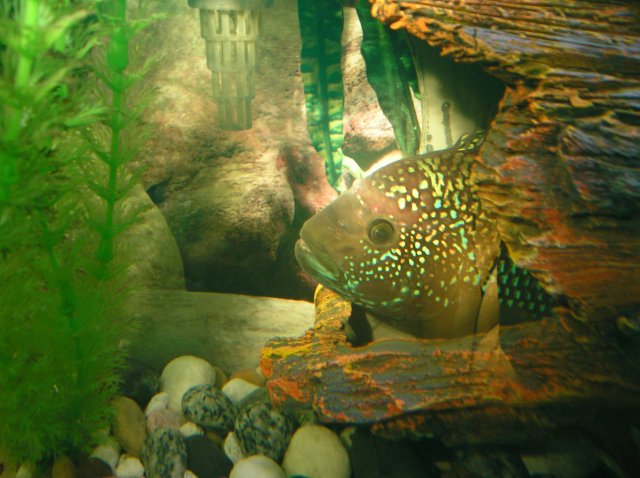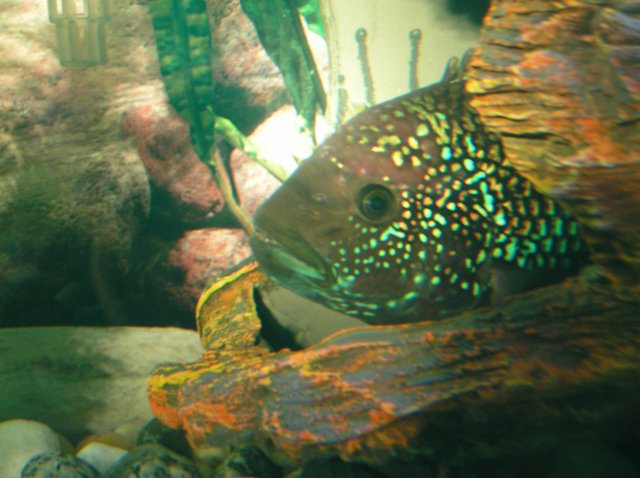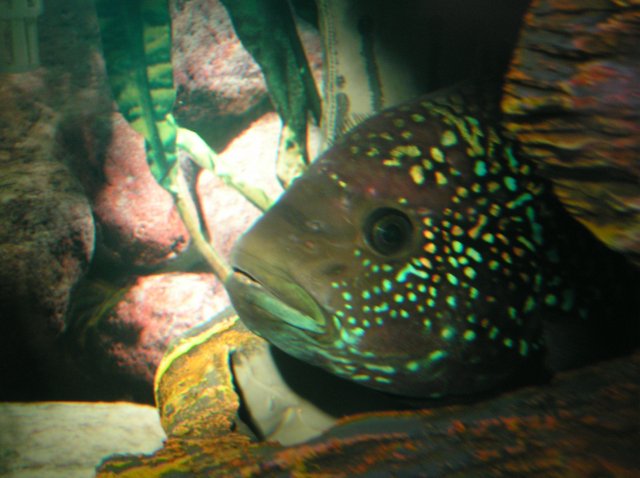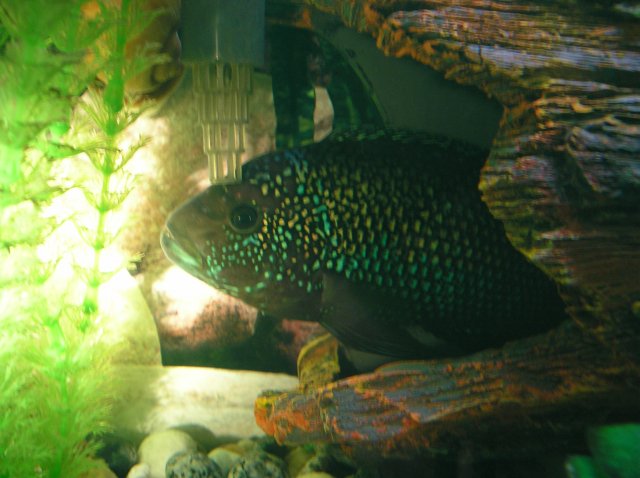My 9" Jack Dempsey has these white almost pimple like things on his forehead. They are outlined in red and have a pointy white thing in the middle. I don't know if its from him ramming himself into rocks and the glass or some type of fungus or bacteria, so I don't know what to use. Can I use melafix and primafix at the same time? If I can, do I cut each in half or full dose?
Jack Dempsey is sick
- Thread starter slowlyburn
- Start date
You are using an out of date browser. It may not display this or other websites correctly.
You should upgrade or use an alternative browser.
You should upgrade or use an alternative browser.
there are a number of diseases that begin this way. (1) tumors or lymphocystis which are viral in origin and not treatable, (2) fish pox which is also viral and not treatable (3) various forms of ulcer disease which are caused by Pseudomonas or Aeromonas and are treatable, (4) HITH or LLE which has varied causes and treatments, (5) Costia - a parasite that nearly always causes little red hemorrhages, especially under the chin, (6) various bacterial diseases caused by such as Columnaris, (7) Neoplasm formations.
Lumps and bumps that suddenly appear are usually infections. If the disease process is due to bacteria, it usually resolves by rupture (like a boil) pretty quickly. The white liquid that oozes out is pus that is formed when the white blood cells (immune cells) die while killing bacteria (in general). NEVER TRY TO POP OR SQUEEZE THE LUMP. Like a boil in humans, squeezing can cause regurgitation of the pus into the blood stream of the fish with deadly results. It is also not a good idea to seal a draining wound unless it is bleeding. The most common bacteria which causes such lumps is Columnaris or Aeromonas.
Wounds that are white on the edges and red in the center are most typically Aeromonas. Those that are red on the edges and white in the center are generally Columnaris. Both are gram negative bacteria. the best treatment for this is any sulfa antibiotic with trimetheprim. this can be put in the water and mixed with food -- if you can find Romet B use it.
Cautionary notes: Some water conditioners can inactivate some medication. NovAqua and PolyAqua will inactivating metals and quickly inactivates potassium permanganate.
Costia treatment is best accomplished by (a) first using a salt dip to strip the slime coat, (b) treat for 3 days with Quick Cure (c) run the temp up to 86°F for 3 days and then (d) slowly lower the temp to normal at a rate of about 4 degrees over a 24 hour period.
treatment for any other 'bumps' and 'lumps' may be treated by a bath of potassium permanganate. you can often obtain this at your local pharmacy.
notes on the use of potassium permanganate. 1 drop of stock PP per gallon is equal to 2 ppm. This is the concentration used for continuous treatment. PP is usually used for 3 days, or every other day for 4 treatments. If water is not clear in 24 hours (looks yellow), change 25-30% of the water before adding another dose. Light inactivates PP. After adding the PP, watch for a minimum of 15 minutes to make sure there are no adverse reaction. Then turn off lights or cover the tank.
Some water seems to inactivate PP rapidly. It should be pink when you put it in, and stay pink for at least 4 hours to be effective.
Stock PP can be used on a swab on small wounds or patches of white "crud" on fins. It results in a chemical burn and turns the area dark. Do not use near the eyes, mouth or gills. Use as a one time application, followed by Neosporin creme or Panalog (by vet prescription).
Epizootic ulcerative syndrome caused by Apahnomyces invadans. this disease works from the inside muscle outward to the dermis/epidermis causing lesions. there has been some reported prophylactic and therapeutic success addressing this parasitic fungus using RALLY in combination with standard doses of the antibiotic Kanamycin available at shops in various formulations.
If you pursue combined RALLY/Kanamycin treatment, use it according to package label instructions, and add one dose of RALLY every 3 - 5 days. The active ingredients in RALLY are biodegradable; however, you should run carbon or a Polyfilter for a few hours (and then remove it) before adding a repeat dose.
If fish don't show lesions after a period of weeks, they are probably not/no longer infected and, therefore, no longer producing infectious spores. No sores + no spores + weeks = cure(?). There isn't much known yet about latent spores ("hyphae") which may survive in the flesh. The fungus does most of its damage in the muscle tissue where the effects are not readily apparent; when the infection breaks through the epidermis and forms an open sore the water is being seeded with infectious spores. Therefore, if your fish show no visible symptoms, let's say for at least four weeks, you probably have been successful it saving them and terminating the infection cycle. However, remember that the infection is invisible during most of its cycle in any given fish: therefore what appeared to be "stopping the infection in its tracks" over a period of 10 days or so doesn't mean the infection was eradicated. Finally, a fish can have multiple tracts of infected muscle, leading ultimately to multiple sores. So, while getting one sore on a fish closed up and healed is a significant achievement, it again doesn't mean much until the fish stays clean for at least two or three weeks.
buy rally here ---> http://www.northcoastmarines.com/rally.html
Hydrogen peroxide is preferred for topical application near the mouth or gills.
Lumps and bumps that suddenly appear are usually infections. If the disease process is due to bacteria, it usually resolves by rupture (like a boil) pretty quickly. The white liquid that oozes out is pus that is formed when the white blood cells (immune cells) die while killing bacteria (in general). NEVER TRY TO POP OR SQUEEZE THE LUMP. Like a boil in humans, squeezing can cause regurgitation of the pus into the blood stream of the fish with deadly results. It is also not a good idea to seal a draining wound unless it is bleeding. The most common bacteria which causes such lumps is Columnaris or Aeromonas.
Wounds that are white on the edges and red in the center are most typically Aeromonas. Those that are red on the edges and white in the center are generally Columnaris. Both are gram negative bacteria. the best treatment for this is any sulfa antibiotic with trimetheprim. this can be put in the water and mixed with food -- if you can find Romet B use it.
Cautionary notes: Some water conditioners can inactivate some medication. NovAqua and PolyAqua will inactivating metals and quickly inactivates potassium permanganate.
Costia treatment is best accomplished by (a) first using a salt dip to strip the slime coat, (b) treat for 3 days with Quick Cure (c) run the temp up to 86°F for 3 days and then (d) slowly lower the temp to normal at a rate of about 4 degrees over a 24 hour period.
treatment for any other 'bumps' and 'lumps' may be treated by a bath of potassium permanganate. you can often obtain this at your local pharmacy.
notes on the use of potassium permanganate. 1 drop of stock PP per gallon is equal to 2 ppm. This is the concentration used for continuous treatment. PP is usually used for 3 days, or every other day for 4 treatments. If water is not clear in 24 hours (looks yellow), change 25-30% of the water before adding another dose. Light inactivates PP. After adding the PP, watch for a minimum of 15 minutes to make sure there are no adverse reaction. Then turn off lights or cover the tank.
Some water seems to inactivate PP rapidly. It should be pink when you put it in, and stay pink for at least 4 hours to be effective.
Stock PP can be used on a swab on small wounds or patches of white "crud" on fins. It results in a chemical burn and turns the area dark. Do not use near the eyes, mouth or gills. Use as a one time application, followed by Neosporin creme or Panalog (by vet prescription).
Epizootic ulcerative syndrome caused by Apahnomyces invadans. this disease works from the inside muscle outward to the dermis/epidermis causing lesions. there has been some reported prophylactic and therapeutic success addressing this parasitic fungus using RALLY in combination with standard doses of the antibiotic Kanamycin available at shops in various formulations.
If you pursue combined RALLY/Kanamycin treatment, use it according to package label instructions, and add one dose of RALLY every 3 - 5 days. The active ingredients in RALLY are biodegradable; however, you should run carbon or a Polyfilter for a few hours (and then remove it) before adding a repeat dose.
If fish don't show lesions after a period of weeks, they are probably not/no longer infected and, therefore, no longer producing infectious spores. No sores + no spores + weeks = cure(?). There isn't much known yet about latent spores ("hyphae") which may survive in the flesh. The fungus does most of its damage in the muscle tissue where the effects are not readily apparent; when the infection breaks through the epidermis and forms an open sore the water is being seeded with infectious spores. Therefore, if your fish show no visible symptoms, let's say for at least four weeks, you probably have been successful it saving them and terminating the infection cycle. However, remember that the infection is invisible during most of its cycle in any given fish: therefore what appeared to be "stopping the infection in its tracks" over a period of 10 days or so doesn't mean the infection was eradicated. Finally, a fish can have multiple tracts of infected muscle, leading ultimately to multiple sores. So, while getting one sore on a fish closed up and healed is a significant achievement, it again doesn't mean much until the fish stays clean for at least two or three weeks.
buy rally here ---> http://www.northcoastmarines.com/rally.html
Hydrogen peroxide is preferred for topical application near the mouth or gills.
My fish has maybe 5-7 white pimple like bumps on the top of his head all being above the eye line.(mainly on his forehead) Also he has a few pits(maybe 3-4) in the same area. I cant get a picture! I dont know what to do!!!
when I photo my fish I litterally take 250 and maybe use one or 2 from that...never hurts to try. it will go along way in us helping you
lol...its a male... you need to see the whole fish.
Those 2 red lines or marks are the only 2 red spots...
Those 2 red lines or marks are the only 2 red spots...






